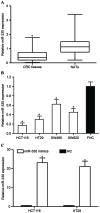MicroRNA-330 inhibited cell proliferation and enhanced chemosensitivity to 5-fluorouracil in colorectal cancer by directly targeting thymidylate synthase
- PMID: 28521444
- PMCID: PMC5431319
- DOI: 10.3892/ol.2017.5895
MicroRNA-330 inhibited cell proliferation and enhanced chemosensitivity to 5-fluorouracil in colorectal cancer by directly targeting thymidylate synthase
Abstract
Colorectal cancer (CRC) is the third most common cancer in males and the second most common in females, worldwide. Currently, 5-fluorouracil (5-FU)-mediated chemotherapy is the adjuvant treatment for patients with CRC following surgical resection. However, a number of patients with CRC develop 5-FU resistance, which is a major challenge for the effective treatment of cancer. Therefore, it is important to investigate the molecular mechanisms underlying chemoresistance and the therapeutic treatments that may improve the treatment of CRC. The present study demonstrated that microRNA (miR)-330 was significantly downregulated in CRC tissues and cell lines. Ectopic miR-330 expression decreased cell proliferation and enhanced cell chemosensitivity to 5-FU via the cell apoptosis pathway in CRC. In addition, thymidylate synthase (TYMS) was revealed to be a direct target gene of miR-330 in CRC. Knockdown of TYMS inhibited CRC cell proliferation, and enhanced cell chemosensitivity to 5-FU by promoting cell apoptosis. In conclusion, the results of the present study indicated that miR-330 targeted TYMS to inhibit the proliferation and enhance the chemosensitivity of CRC cells to 5-FU by promoting cell apoptosis. The present study provided important insight into the molecular mechanism underlying 5-FU-mediated chemoresistance and a novel therapeutic strategy for the enhancement of efficacy in CRC treatment.
Keywords: 5-fluorouracil; chemosensitivity; colorectal cancer; microRNA-330; proliferation; thymidylate synthase.
Figures







Similar articles
-
MicroRNA-375-3p enhances chemosensitivity to 5-fluorouracil by targeting thymidylate synthase in colorectal cancer.Cancer Sci. 2020 May;111(5):1528-1541. doi: 10.1111/cas.14356. Epub 2020 Mar 14. Cancer Sci. 2020. PMID: 32073706 Free PMC article.
-
miR-203 enhances chemosensitivity to 5-fluorouracil by targeting thymidylate synthase in colorectal cancer.Oncol Rep. 2015 Feb;33(2):607-14. doi: 10.3892/or.2014.3646. Epub 2014 Dec 4. Oncol Rep. 2015. PMID: 25482885
-
MicroRNA-218 is a prognostic indicator in colorectal cancer and enhances 5-fluorouracil-induced apoptosis by targeting BIRC5.Carcinogenesis. 2015 Dec;36(12):1484-93. doi: 10.1093/carcin/bgv145. Epub 2015 Oct 6. Carcinogenesis. 2015. PMID: 26442524
-
Role of microRNAs in the resistance of colorectal cancer to chemoradiotherapy.Mol Clin Oncol. 2018 Apr;8(4):523-527. doi: 10.3892/mco.2018.1578. Epub 2018 Feb 20. Mol Clin Oncol. 2018. PMID: 29556386 Free PMC article. Review.
-
Molecular determinants of response to 5-fluorouracil-based chemotherapy in colorectal cancer: The undisputable role of micro-ribonucleic acids.World J Gastrointest Oncol. 2020 Sep 15;12(9):942-956. doi: 10.4251/wjgo.v12.i9.942. World J Gastrointest Oncol. 2020. PMID: 33005290 Free PMC article. Review.
Cited by
-
5-Fluorouracil resistance mechanisms in colorectal cancer: From classical pathways to promising processes.Cancer Sci. 2020 Sep;111(9):3142-3154. doi: 10.1111/cas.14532. Epub 2020 Aug 13. Cancer Sci. 2020. PMID: 32536012 Free PMC article. Review.
-
An insight into thymidylate synthase inhibitor as anticancer agents: an explicative review.Naunyn Schmiedebergs Arch Pharmacol. 2024 Aug;397(8):5437-5448. doi: 10.1007/s00210-024-03020-y. Epub 2024 Mar 6. Naunyn Schmiedebergs Arch Pharmacol. 2024. PMID: 38446215 Review.
-
MicroRNAs as Predictive Biomarkers in Patients with Colorectal Cancer Receiving Chemotherapy or Chemoradiotherapy: A Narrative Literature Review.Cancers (Basel). 2023 Feb 21;15(5):1358. doi: 10.3390/cancers15051358. Cancers (Basel). 2023. PMID: 36900159 Free PMC article. Review.
-
MALAT1-miRNAs network regulate thymidylate synthase and affect 5FU-based chemotherapy.Mol Med. 2022 Aug 3;28(1):89. doi: 10.1186/s10020-022-00516-2. Mol Med. 2022. PMID: 35922756 Free PMC article. Review.
-
Molecular and Kinetic Analyses of Circulating Tumor Cells as Predictive Markers of Treatment Response in Locally Advanced Rectal Cancer Patients.Cells. 2019 Jun 26;8(7):641. doi: 10.3390/cells8070641. Cells. 2019. PMID: 31247977 Free PMC article.
References
LinkOut - more resources
Full Text Sources
Other Literature Sources
